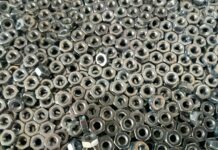Denim is a robust, sturdy cotton fabric with a unique diagonal ribbing pattern. Its textured surface is what gives it its iconic look. It is a high-quality fabric that is both affordable and durable. It also irons easily and creases well, making it suitable for various projects.
Stretchability
One of denim fabric characteristics is its stretchability which depends on its fiber content and weave. It can be incorporated in different ways to achieve various types of stretchability. For example, some denim fabrics blend cotton and synthetics like spandex or elastane to make them more stretchy. This is especially useful for more fitted styles of jeans. The ridged texture that makes denim so distinct comes from the twill weaving technique.
The most common type of twill is a 3×1 right-hand twill, which means that on the fabric’s face (i.e., the front), there are three warp threads for every weft thread. The twill lines then run from the right to the left on the fabric’s face. The twill weave also gives denim its strength and hardwearing nature. Many jeans are made with a blend of cotton and polyester to help prevent shrinkage and wrinkles.
Other non-apparel uses include bags, shoes, jackets, purses, and furnishing covers. The twill weave also lends itself to a variety of washes. Some of these washes include stone, acid, and bleach.
Read Also – Top Industries That Can Benefit From Producing Printed Brochures
Twill
The twill fabric that gives jeans iconic diagonal lines is the secret to their durability. The interlacing of warp threads and filling yarns create a sturdy textile that can withstand rough wear and tear. Its malleability also allows it to be worn and distressed in many ways, including by abrasion. The color of denim is derived from the dyes used to color the warp threads.
The dyes are absorbed by the cotton fibers near the surface, which cause them to fade as they are washed and worn. This is one of the reasons why turning your jeans inside out when washing them is essential. The most common type of twill in jeans is a 3×1 right-hand twill. This means that on the face of the fabric, there are three warp yarns for every weft yarn, and the twill lines run from right to left.
Other types of twill weaves can be used in jeans, such as 2×1 twill and selvage denim. However, these fabrics are less durable and don’t have the same flexibility as jean fabric.
Indigo dye
Indigo dye is an essential ingredient in the production of denim fabric. It imparts a blue tint to the material, allowing it to react to various washing and finishing applications, giving it its signature worn look. It is a natural color that can be found in plants and trees. Its usage has been documented across different cultures over centuries. Creating denim is lengthy, involving harvesting cotton, yarn spinning, indigo dyeing, weaving, and fabric finishing.
After the cotton is harvested and yarn spun, it goes through a series of washes to prepare it for dyeing. The raw cotton is soaked and dried 15-20 times during the indigo dyeing. This helps to reduce the amount of dye needed. Then, the paint is applied to the skeins of the yarn. The yarn is then woven into the desired fabric. This fabric can be used in various ways, including skinny jeans and jackets. It also has a unique mottled appearance that makes it appealing to many consumers.
Weight
Denim fabric is a versatile textile used in various clothing and accessories. The fabric takes dye well and can be manipulated to create multiple aesthetic effects. It can also be mixed with other fabrics, such as elastane or lyocell, to highlight a particular characteristic.
The weight of a denim fabric is determined by the thickness and density of its yarns. It can be divided into three categories: lightweight, mid-weight, and heavyweight. The thickness and density of the threads will affect how stiff the fabric is and how it behaves. Usually, a yard of the fabric will weigh between 9 and 32 oz. The oz refers to how many ounces a square yard of the fabric weighs, and it can be unclear for those unfamiliar with the metric system. The thicker the yarns, the more the fabric will weigh.
However, the oz doesn’t tell the whole story. The material can also be prewashed or softened using ozone treatments (similar to stone washing). The effect of this treatment will affect how stiff the fabric is.
Care
To produce denim, the cotton goes through various stages. This includes harvesting, separating cotton fibers from their seeds, making yarn, and dyeing it. It is also treated with saffronisation, which makes it resistant to shrinkage during the first wash. The result is a durable fabric that does not fade even with regular use.
Moreover, cotton can be easily dyed and shaped to create different types of fabrics. This is why it was used to make jeans, a staple in many people’s wardrobes. It is also famous for shirts, dresses, jackets, and bags. Its malleability allows designers to distress and age the fabric to give it a unique look. The twill weave that gives denim its distinctive diagonal ridged texture is sturdy and long-lasting but less stretchy than other woven fabrics. Some manufacturers add elastane or spandex to denim to increase its stretchability and allow for more fitted garments styles.
However, it is essential to know that these materials are not organic and contain toxins from chemical fertilizers and petrochemicals used in their cultivation. These toxins pollute ecosystems and cause health complications for plants, animals, and humans.
Read Also – The Ultimate Guide to Packing Well for Hostel Life in Indore


I am a passionate blogger and developer sharing business tips. I Help others solve programming problems on various online forums.
You must follow these marketing tactics to promote your business online.























